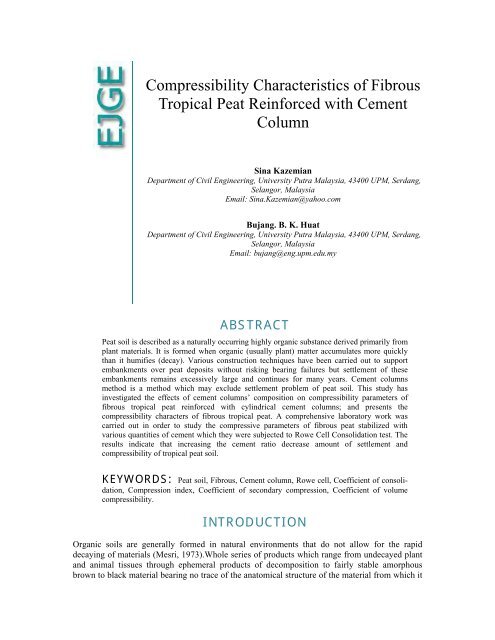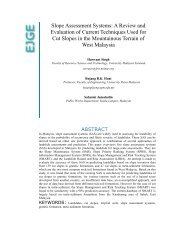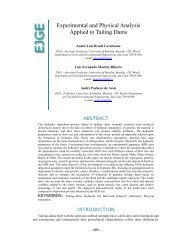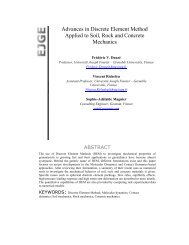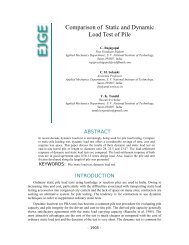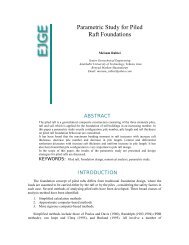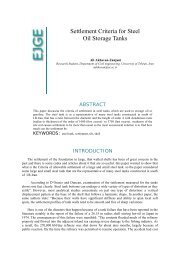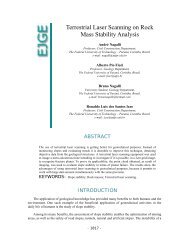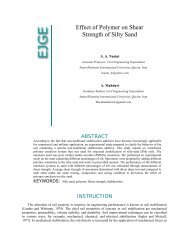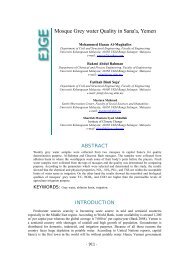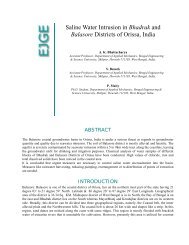Compressibility Characteristics of Fibrous Tropical Peat ... - Ejge.com
Compressibility Characteristics of Fibrous Tropical Peat ... - Ejge.com
Compressibility Characteristics of Fibrous Tropical Peat ... - Ejge.com
You also want an ePaper? Increase the reach of your titles
YUMPU automatically turns print PDFs into web optimized ePapers that Google loves.
<strong>Compressibility</strong> <strong>Characteristics</strong> <strong>of</strong> <strong>Fibrous</strong><br />
<strong>Tropical</strong> <strong>Peat</strong> Reinforced with Cement<br />
Column<br />
Sina Kazemian<br />
Department <strong>of</strong> Civil Engineering, University Putra Malaysia, 43400 UPM, Serdang,<br />
Selangor, Malaysia<br />
Email: Sina.Kazemian@yahoo.<strong>com</strong><br />
Bujang. B. K. Huat<br />
Department <strong>of</strong> Civil Engineering, University Putra Malaysia, 43400 UPM, Serdang,<br />
Selangor, Malaysia<br />
Email: bujang@eng.upm.edu.my<br />
ABSTRACT<br />
<strong>Peat</strong> soil is described as a naturally occurring highly organic substance derived primarily from<br />
plant materials. It is formed when organic (usually plant) matter accumulates more quickly<br />
than it humifies (decay). Various construction techniques have been carried out to support<br />
embankments over peat deposits without risking bearing failures but settlement <strong>of</strong> these<br />
embankments remains excessively large and continues for many years. Cement columns<br />
method is a method which may exclude settlement problem <strong>of</strong> peat soil. This study has<br />
investigated the effects <strong>of</strong> cement columns’ <strong>com</strong>position on <strong>com</strong>pressibility parameters <strong>of</strong><br />
fibrous tropical peat reinforced with cylindrical cement columns; and presents the<br />
<strong>com</strong>pressibility characters <strong>of</strong> fibrous tropical peat. A <strong>com</strong>prehensive laboratory work was<br />
carried out in order to study the <strong>com</strong>pressive parameters <strong>of</strong> fibrous peat stabilized with<br />
various quantities <strong>of</strong> cement which they were subjected to Rowe Cell Consolidation test. The<br />
results indicate that increasing the cement ratio decrease amount <strong>of</strong> settlement and<br />
<strong>com</strong>pressibility <strong>of</strong> tropical peat soil.<br />
KEYWORDS: <strong>Peat</strong> soil, <strong>Fibrous</strong>, Cement column, Rowe cell, Coefficient <strong>of</strong> consolidation,<br />
Compression index, Coefficient <strong>of</strong> secondary <strong>com</strong>pression, Coefficient <strong>of</strong> volume<br />
<strong>com</strong>pressibility.<br />
INTRODUCTION<br />
Organic soils are generally formed in natural environments that do not allow for the rapid<br />
decaying <strong>of</strong> materials (Mesri, 1973).Whole series <strong>of</strong> products which range from undecayed plant<br />
and animal tissues through ephemeral products <strong>of</strong> de<strong>com</strong>position to fairly stable amorphous<br />
brown to black material bearing no trace <strong>of</strong> the anatomical structure <strong>of</strong> the material from which it
Vol. 14, Bund. C 2<br />
was derived; and it is this latter material that is defined as the soil humus have defined soil<br />
organic matter by Russell (1952).<br />
To a geotechnical engineer, all soils with organic content <strong>of</strong> greater than 20% is known as organic<br />
soil. <strong>Peat</strong> soil is an organic soil with organic content <strong>of</strong> more than 75% (Huat, 2004). This classification<br />
is partly the same as ASTM D 2487 classification; a soil with organic content less than<br />
75% (or ash content more than 25%) as muck or organic soil, while a soil with organic content<br />
higher than 75% (or ash content less than 25%) as a peat. For geotechnical purposes, peat degree<br />
<strong>of</strong> de<strong>com</strong>position or humification system <strong>of</strong> Von Post (1922) is <strong>of</strong>ten reduced to 3 classes<br />
(Magnan, 1980; ASTM Standard D 5715): I. Fibric or fibrous (least de<strong>com</strong>posed). II. Hemic or<br />
semi-fibrous (intermediate de<strong>com</strong>posed). III. Sapric or amorphous (most de<strong>com</strong>posed).<br />
The amorphous peat particles, in which the cell structure is still visible, are the product <strong>of</strong><br />
biochemical de<strong>com</strong>position and breakdown <strong>of</strong> fibrous peats and other plant remains. Amorphous<br />
peat deposits are more likely to include a significant amount <strong>of</strong> inorganic matter. As <strong>com</strong>pared to<br />
fibrous peat deposits, the amorphous peat fabric is likely to exist at lower void ratios and to<br />
display lower permeability anisotropy, lower <strong>com</strong>pressibility, lower friction angle, and higher<br />
coefficient <strong>of</strong> earth pressure at rest (Edil and Wang, 2000).<br />
<strong>Fibrous</strong> peat is peat with high organic and fiber content with low degree <strong>of</strong> humification. The<br />
behavior <strong>of</strong> fibrous peat is different from mineral soil because <strong>of</strong> different phase properties and<br />
microstructure (Edil, 2003). Landva and Pheeney (1980), Landva and La Rochelle (1983) described<br />
fibrous peat particles consist <strong>of</strong> fragments <strong>of</strong> long stems, thin leaves, rootlets, cell walls, and<br />
fibers, <strong>of</strong>ten are quite large. Stem diameters <strong>of</strong> 20 to 500µm, leaf thicknesses <strong>of</strong> 10 to 15 µm, and<br />
width and length <strong>of</strong> 100 to 1,200 µm are <strong>com</strong>mon. Scanning electron micro-photographs (SEMs)<br />
<strong>of</strong> James Bay peat in Figure 1(a), (b) illustrate hollow perforated cellular structures and a network<br />
<strong>of</strong> fibrous elements in vertical and horizontal section (Mesri and Ajlouni, 2007).<br />
a<br />
b<br />
Figure 1: Scanning electron microphotograph <strong>of</strong> (a) vertical section; (b) horizontal section (Mesri<br />
and Ajlouni, 2007)<br />
<strong>Peat</strong> is found in all part <strong>of</strong> the world except in deserts and the arctic regions. The most extensive<br />
areas are located in the northern hemisphere. It is estimated that there are about 1 billion acres <strong>of</strong><br />
peat land in the world or about 4.5% <strong>of</strong> total land areas. In United State; peat is found in 42 states<br />
with a total area <strong>of</strong> 50 million hectares, Canada has 110 million hectares and former USSR 150<br />
million hectares. In Japan peat is widely distributed throughout Hokkaido, which is the northern
Vol. 14, Bund. C 3<br />
<strong>of</strong> island Japan, with an area <strong>of</strong> approximately 200 thousand hectares. The total area <strong>of</strong> tropical<br />
peat swamp forest or tropical peat land in the world amounts to about 30 million hectares<br />
(Deboucha et al., 2008). Various construction techniques have been carried out to support<br />
embankments over peat deposits without risking bearing failures but settlement <strong>of</strong> these<br />
embankments remains excessively large and continues for many years. Besides settlement,<br />
stability problems during construction such as localized bearing failures and slip failures need to<br />
be considered (Duraisamy et al., 2007-b).<br />
Due to fibrous hollow perforated cellular structures, which it has stated above, the large<br />
<strong>com</strong>pressibility <strong>of</strong> peat results in a large deformations and strains. Yulindasari (2006) emphasised<br />
the <strong>com</strong>pressibility behavior <strong>of</strong> fibrous peat is different from that <strong>of</strong> clay soil. The behavior is<br />
controlled by several factors including the initial water content, fiber arrangement, and fiber<br />
content. The condition in which the fibrous peat is deposited is also an important factor to be<br />
considered. This study is focused on the <strong>com</strong>pressibility characteristics <strong>of</strong> fibrous peat based on<br />
time-<strong>com</strong>pression curves derived from consolidation tests.<br />
<strong>Compressibility</strong> Parameters <strong>of</strong> <strong>Fibrous</strong> <strong>Peat</strong><br />
High organic maters are indicator for high <strong>com</strong>pressibility and swell characteristics <strong>of</strong> the soils<br />
(Mesri and Ajlouni, 2007; Anand J. et al. 2007; Kazemian et al. 2009). <strong>Fibrous</strong> peat undergoes<br />
large settlements in <strong>com</strong>parison to clays when subjected to loading. The <strong>com</strong>pression behavior <strong>of</strong><br />
fibrous peat varies from the <strong>com</strong>pression behavior <strong>of</strong> other types <strong>of</strong> soils in two ways. First, the<br />
<strong>com</strong>pression <strong>of</strong> peat is much larger than <strong>of</strong> other soils. Second, the creep portion <strong>of</strong> settlement<br />
plays a more significant role in determining the total settlement <strong>of</strong> peat than <strong>of</strong> other soil types.<br />
The primary consolidation <strong>of</strong> the fibrous peat is very rapid, and large secondary <strong>com</strong>pression,<br />
even tertiary <strong>com</strong>pression is observed. Secondary <strong>com</strong>pression is generally found as the more<br />
significant part <strong>of</strong> <strong>com</strong>pression because the time rate is much slower than the primary<br />
consolidation (Yulindasari, 2006).<br />
Compression <strong>of</strong> fibrous peat continues at a gradually decreasing rate under constant effective<br />
stress, and this is termed as the secondary <strong>com</strong>pression. The secondary <strong>com</strong>pression <strong>of</strong> peat is<br />
thought to be due to further de<strong>com</strong>position <strong>of</strong> fiber which is conveniently assumed to occur at a<br />
slower rate after the end <strong>of</strong> primary consolidation (Mesri et al., 1997).<br />
The main <strong>com</strong>pressibility parameters in soils which were examined to assess the effect <strong>of</strong> the<br />
cement column to the consolidation parameters <strong>of</strong> the peat in this paper are: Coefficient <strong>of</strong> consolidation,<br />
c v , Compression index, C c , Coefficient <strong>of</strong> secondary <strong>com</strong>pression, C α , Coefficient <strong>of</strong><br />
volume <strong>com</strong>pressibility, m v .<br />
EXPERIMENTAL DESIGN AND LABORATORY WORK<br />
This paper is mainly concerned with fibrous peat, and presents an interpretation <strong>of</strong> the <strong>com</strong>pressibility<br />
parameters <strong>of</strong> fibrous peat after the installation <strong>of</strong> cement column with different ratios<br />
cement by using data from Rowe Cell Consolidation test on undisturbed samples <strong>of</strong> several<br />
fibrous peats taken from Kampung Jawa Klang, Selangor, Malaysia.
Vol. 14, Bund. C 4<br />
Sample preparation<br />
This study took undisturbed samples <strong>of</strong> peat soil from Kampung Jawa Klang, Selangor, in<br />
Malaysia with a sampling tube and containers capable <strong>of</strong> being sealed to prevent the loss or gain<br />
<strong>of</strong> moisture. Jolting during transports was avoided. The researchers in this study designed and<br />
fabricated a suitable auger with a sampling tube and containers to collect undisturbed peat<br />
samples, as shown in Figure 2. Refer to BS 1377-1 for the preparation methods.<br />
Researchers <strong>of</strong> this study formed the handle from a 60 cm crossbar and the stem was 100 cm<br />
high. The interior <strong>of</strong> the cylindrical tube was 150 mm in diameter. It's fitted the upper part <strong>of</strong> the<br />
hollow cylindrical body with a cover plate and the thin tube with a valve designed to be left open<br />
during sampling to release both air and water pressure. Meanwhile, the lower part <strong>of</strong> the<br />
cylindrical tube was sharpened to cut roots as the auger slowly rotated into the peat ground during<br />
sampling. The auger’s operators then close the valve prior to the withdrawal <strong>of</strong> the tube with the<br />
peat sample enclosed, thus providing a vacuum effect to help hold the sample in place. Soon after<br />
the operators withdrew the sampler they sealed the cylindrical tube with paraffin wax.<br />
Once in the laboratory, we opened the top cover <strong>of</strong> the cylindrical tube to extract the sample. The<br />
auger enables the extraction <strong>of</strong> peat core samples 150 mm in diameter and 230 mm long. We<br />
trimmed the top and bottom <strong>of</strong> the specimen. As fibrous soil such as peat is easily disturbed, we<br />
carried out the trimming process carefully and quickly to minimize any change in the soil<br />
sample’s water content. All tests reported here were performed inside a constant temperature<br />
room at 20±2°C.<br />
Figure 2: Sampler fabricated to collect undisturbed peat samples<br />
These procedures, including the setting up <strong>of</strong> the specimen in the Rowe Cell apparatus, covered<br />
the preparation <strong>of</strong> a cylindrical test specimen <strong>of</strong> the original soil sample. The specimens’ heights<br />
and diameters <strong>of</strong> samples were 50, 150 mm respectively, as shown in Figure 3(a).
Vol. 14, Bund. C<br />
5<br />
a<br />
b<br />
Figure 3: (a) A cylindrical test specimen<br />
from the original soil sample after trimming. (b)<br />
Method used to set up<br />
cement column in specimen.<br />
For preparing the<br />
peat reinforced with cement in order to investigate its <strong>com</strong>pressibility<br />
parameters, this study placed a single PVC tube at the center <strong>of</strong> the peat specimen<br />
and used it to<br />
remove a portion <strong>of</strong> the peat soil from the cell and replace it with dry<br />
ordinary Portland cement<br />
mixed<br />
with different amounts <strong>of</strong> peat soil, the cement-peat ratios tested being 10% %, 20%, 30% %,<br />
and 50% by the air dry weight <strong>of</strong> the peat<br />
base on BS<br />
1377-1(7.3.4)) (Table 1). The cement<br />
column’s diameter<br />
was 45 mm. The area ratio <strong>of</strong> column to sample was 0.09 (Figure 3(b)).<br />
Table 1: Various quantities <strong>of</strong> cement in samples were subjected in this study.<br />
This study then cured the samples for 28<br />
days in a soaking basin with natural peat water<br />
(collected from peat site), as shown in Figure 4(a) and (b), then carried out the <strong>com</strong>pressibility<br />
test on each sample consecutively. In Figure 4(a) and (b), method used for cure peat reinforced<br />
with cement column and taking natural peat water for curing samples are shown respectively.<br />
<strong>Peat</strong><br />
water<br />
a<br />
b<br />
Figure 4: (a) Method used to cure peat cement column into specimen (Kazemian et<br />
al. 2008). (b)<br />
Collecting natural peat water for curing the samples.
Vol. 14, Bund. C 6<br />
Testing programs<br />
The samples were from marine and continental deposits <strong>of</strong> the Kampung Jawa Klang, Selangor,<br />
west coast <strong>of</strong> the Malaysian peninsula. They consisted primarily <strong>of</strong> fibrous organic soils and some<br />
fine-to-medium sands and were dark brown in color.<br />
As mentioned earlier, this study prepared the samples in accordance with BS 1377-1 (1990). We<br />
determined such physical properties <strong>of</strong> natural soil used in the tests as organic content, water<br />
content, liquid limit, and specific gravity in accordance with BS 1377-3(4) (1990), BS 1377-2(3)<br />
(1990), BS 1377-2(4.3) (1990), and BS 1377-2(8.4) (1990), respectively. We determined the<br />
organic matter (content) <strong>of</strong> the peat samples based on test procedures according to ASTM D<br />
2974-87, and used the Von Post scale to find the degree <strong>of</strong> humification (Huat, 2004). Sample<br />
was then tested using Rowe Cell to over<strong>com</strong>e most <strong>of</strong> the disadvantages <strong>of</strong> the conventional<br />
oedometer apparatus when performing consolidation tests on low permeability soils, including<br />
non uniform deposits. The most important features are the ability to control drainage and to<br />
measure pore water pressure during the course <strong>of</strong> consolidation tests (Duraisamy et al., 2007-a,<br />
2007-b).<br />
Figure 5: Rowe Cell Consolidation test set up used in this study.<br />
The system was <strong>com</strong>prised <strong>of</strong> a Rowe Cell Consolidation, gradually diverging system (GDS)<br />
pressure and volume controllers (Figure 5), and GDS laboratory s<strong>of</strong>tware. The hydraulic loading<br />
system pressure and vertical loads (50, 100, 200 and 300kPa) can be applied to the sample surface<br />
either via a flexible diaphragm to give a uniformly distributed pressure (free strain) or via a rigid<br />
plate to give uniform settlement (equal strain). The bottom drain is provided with a tapping to a<br />
pressure transducer.<br />
This study performed the consolidation tests on low permeability soils on the peat based on BS<br />
1377-6 1990 and determined the <strong>com</strong>pressibility parameters <strong>of</strong> the samples without having to remove<br />
them from their sampling tubes. The samples therefore didn’t suffer disturbance due to<br />
their preparation, and the moisture content <strong>of</strong> the soils at the respective test horizons could be<br />
reported.<br />
The <strong>com</strong>pressibility parameters in soils which were tested to assess the effect <strong>of</strong> the cement<br />
column with different cement ratio, to the consolidation parameters <strong>of</strong> the peat in this study are:<br />
1. Coefficient <strong>of</strong> consolidation (C v ) 2. Compression index (C c ) 3. Coefficient <strong>of</strong> secondary <strong>com</strong>pression<br />
(C α ), and 4. Coefficient <strong>of</strong> volume <strong>com</strong>pressibility (m v ).
Vol. 14, Bund. C 7<br />
RESULTS AND DISCUSSION<br />
Physical characteristics <strong>of</strong> Untreated (Natural) <strong>Peat</strong><br />
This study performed the basic tests on natural fibrous tropical peat soil. Table 2, with some<br />
characteristics and indications <strong>of</strong> the concentration at which all <strong>of</strong> the studied organic <strong>com</strong>pound<br />
are usually found in soils. It obtained a range <strong>of</strong> values almost in line with such other researchers<br />
as Ajlouni (2000), Huat (2004), Duraisamy et al. (2007-a) and (2007-b), Alwi (2007), Kazemian<br />
et al. (2009), Kalantari and Huat (2009).<br />
Table 2: Physical characteristics <strong>of</strong> the tested soil (untreated peat)<br />
Coefficient <strong>of</strong> consolidation (C v )<br />
There is a significance decrease in the coefficient <strong>of</strong> consolidation <strong>of</strong> the undisturbed samples<br />
with an increase in effective stress above the apparent pre-consolidation pressure (σ c ) (Huat,<br />
2004). Farrell et al. (1994) reported this decrease is more marked in the samples, which had the<br />
higher organic contents. The coefficient <strong>of</strong> consolidation for a particular pressure from<br />
consolidation test can be determined by curve fitting methods by using two methods:<br />
1. The logarithmic time (Cassagrande’s) method; and<br />
2. The square root time (Taylor’s) method.<br />
For fibrous peat, the results indicate that the coefficient <strong>of</strong> consolidation (C v ) decreased by<br />
increasing the load (consolidation pressure) and cement ratio simultaneously. The coefficient <strong>of</strong><br />
consolidation was decreased around 40%, by increasing consolidation pressure and cement ratio<br />
to 300kPa and 50%, respectively (Figure 6).
Vol. 14, Bund. C 8<br />
Coefficient <strong>of</strong> consolidation, Cv<br />
(m²/year)<br />
5.4<br />
4.9<br />
4.4<br />
3.9<br />
3.4<br />
2.9<br />
2.4<br />
1.9<br />
0 100 200 300 400<br />
Consolidation Pressure (kPa)<br />
Untreated <strong>Peat</strong><br />
Sample A<br />
Sample B<br />
Sample C<br />
Sample D<br />
Figure 6: Coefficient <strong>of</strong> consolidation versus consolidation pressure.<br />
Compression index (C c )<br />
The rate <strong>of</strong> <strong>com</strong>pression index in the standard consolidation test can be defined by the slope (C c )<br />
<strong>of</strong> the final part <strong>of</strong> the void ratio versus logarithmic <strong>of</strong> load (log p) curve. Based on Figure 7, the<br />
<strong>com</strong>pression index (C c ) values from Rowe Cell consolidation test for the natural fibric peat,<br />
sample A, B, C, and D; were 1.809, 1.723, 1.467, 1.343, and 1.098 respectively, for consolidation<br />
pressure <strong>of</strong> 50 kPa. It means by increasing the cement ratio the <strong>com</strong>pression index (C c ) is<br />
decreased gradually. The fibrous reinforced peat is cured in water peat that’s why; it obtained a<br />
little different <strong>of</strong> values with such other researchers.<br />
2.1<br />
Compresion Index, Cc<br />
1.8<br />
1.5<br />
1.2<br />
0.9<br />
0.6<br />
0 10 20 30 40 50 60<br />
Cement Ratio (%)<br />
Figure 7: Compression index versus cement ratio in peat soil.<br />
Coefficient <strong>of</strong> secondary <strong>com</strong>pression, Cα<br />
For the following three reasons, secondary <strong>com</strong>pression and associated settlement are <strong>of</strong>ten more<br />
significant for peat deposits than other geotechnical materials: (1) fibrous peat deposits display<br />
the highest values <strong>of</strong> Cc; (2) fibrous peat deposits have the highest values <strong>of</strong> C α /C c ; and (3)<br />
primary consolidation <strong>of</strong> fibrous peat layers in the field is <strong>com</strong>pleted <strong>com</strong>monly within a few<br />
weeks or months (Mesri and Ajlouni, 2007). Primary consolidation and secondary <strong>com</strong>pressions<br />
can take place simultaneously. However, it is assumed that the secondary <strong>com</strong>pression is<br />
negligible during primary consolidation, and is identified after primary consolidation is<br />
<strong>com</strong>pleted (Lefebvre et al., 1984; Hobbs, 1986; Kogure et al., 1986).
Vol. 14, Bund. C 9<br />
Ratio <strong>of</strong> <strong>com</strong>pressibility, Cα/Cc<br />
0.15<br />
0.135<br />
0.12<br />
0.105<br />
0.09<br />
0.075<br />
0.06<br />
0.045<br />
0.03<br />
0.015<br />
0<br />
0 100 200 300 400<br />
Consolidation Pressure (kPa)<br />
Untreated <strong>Peat</strong><br />
Sample A<br />
Sample B<br />
Sample C<br />
Sample D<br />
Figure 8: Ratio <strong>of</strong> <strong>com</strong>pressibility versus consolidation pressure.<br />
The coefficient <strong>of</strong> secondary <strong>com</strong>pression C α was determined from the slope <strong>of</strong> the e-log (t)<br />
curves during the period <strong>of</strong> 4 to 24 hours after load increment, assuming that the secondary<br />
<strong>com</strong>pression would have started 4 hours after loading. The soil with C α /C c values <strong>of</strong> more than<br />
0.064 is classified as soil with extremely high secondary <strong>com</strong>pressibility (Merci, 1973).<br />
Secondary <strong>com</strong>pression behavior <strong>of</strong> soils is <strong>com</strong>pletely explained and predicted by the C α /C c law<br />
<strong>of</strong> <strong>com</strong>pressibility (Mesri and Godlewski 1977, 1979; Mesri and Castro 1987; Mesri 1987; Mesri<br />
et al. 1994, 1997).<br />
Figure 8 depicts the measured ratio <strong>of</strong> <strong>com</strong>pressibility (C α /C c ) <strong>of</strong> untreated fibrous peat and<br />
reinforced fibrous peat by cement column. Ratio <strong>of</strong> <strong>com</strong>pressibility <strong>of</strong> peat is increased by<br />
increasing the consolidation pressure subsequently from 0.0678 to 0.1038 for 50 to 300 kPa<br />
consolidation pressure respectively. On the other hand, the ratio <strong>of</strong> <strong>com</strong>pressibility (C α /C c ) is<br />
influenced with the addition <strong>of</strong> cement and it is declined. E.g., the low <strong>of</strong> <strong>com</strong>pressibility (C α /Cc)<br />
is declined from 0.0678 to 0.039 for untreated soil by adding cement 50% for consolidation<br />
pressure <strong>of</strong> 50 kPa and it is decreased from 0.1038 to 0.0774 for consolidation pressure <strong>of</strong> 300<br />
kPa too (Figure 8).<br />
Coefficient <strong>of</strong> volume <strong>com</strong>pressibility (m v )<br />
This parameter is very useful to estimate the primary consolidation settlement. The e-p’ curve is<br />
used to obtain coefficient <strong>of</strong> axial <strong>com</strong>pressibility a v and thus the coefficient <strong>of</strong> volume<br />
<strong>com</strong>pressibility m v , while the e-log p’ is used to obtain <strong>com</strong>pression index, C c and preconsolidation<br />
pressure (σ’ c ).<br />
The coefficient <strong>of</strong> volume <strong>com</strong>pressibility (m v )-consolidation pressure relationship, as shown in<br />
Figure 9, exhibits coefficient <strong>of</strong> volume <strong>com</strong>pressibility is gradually decreased by increasing the<br />
consolidation pressure and cement ratio. Because <strong>of</strong> the hardened skeleton matrix formed by<br />
cement particles bonding with adjacent soil particles in the presence <strong>of</strong> water in its pores, the<br />
<strong>com</strong>pressibility characters <strong>of</strong> soils is improved. E.g., the coefficient <strong>of</strong> volume <strong>com</strong>pressibility<br />
(m v ) is declined from 1.48E-3 to 0.98E-3 for untreated soil by adding cement 50% for consolidation<br />
pressure <strong>of</strong> 50 kPa.
Vol. 14, Bund. C 10<br />
Coefficient <strong>of</strong> <strong>com</strong>pressibility,<br />
mv (m2/MN)<br />
1.6<br />
1.2<br />
0.8<br />
0.4<br />
0<br />
0 100 200 300 400<br />
Consolidation Pressure (kPa)<br />
Untreated <strong>Peat</strong><br />
Sample A<br />
Sample B<br />
Sample C<br />
Sample D<br />
Figure 9: coefficient <strong>of</strong> volume <strong>com</strong>pressibility versus consolidation pressure.<br />
It should be noted that, the declining <strong>of</strong> the coefficients <strong>of</strong> volume <strong>com</strong>pressibility gradually,<br />
means the minimum consolidation pressure in this study (50kPa) is more than pre-consolidation<br />
pressure samples. Otherwise, due to consolidation pressure is lower than the pre-consolidation<br />
pressure, the soil sample swell then lower value was obtained for the coefficient <strong>of</strong> volume<br />
<strong>com</strong>pressibility (m v ) under consolidation pressure <strong>of</strong> 50 kPa.<br />
CONCLUSIONS<br />
This study was conducted to explore the influenced <strong>of</strong> the various quantities <strong>of</strong> cement on<br />
<strong>com</strong>pressibility parameters <strong>of</strong> fibrous peat by installing a cement column in undisturbed soils. In<br />
all, 4 cement ratio (10, 20, 30, and 50%) were added to undisturbed fibrous peat soil which taken<br />
from below the water table, as well as laboratory and field data on fibrous peats from the<br />
literature.<br />
The specimens were then cured in water which was collected from the peat site. Then, <strong>com</strong>pressibility<br />
behavior <strong>of</strong> the peat soil was determined by Rowe Cell consolidation test for both the<br />
natural (untreated) and reinforced fibrous peat by cement columns for consolidation pressure 50,<br />
100, 200, and 300 kPa.<br />
The following conclusions are based on the analyses, data, and interpretation presented in this<br />
paper:<br />
1. The coefficient <strong>of</strong> consolidation (C v ) is in the range <strong>of</strong> 4.95-2.78 (m 2 /year) and 4.21-2.05<br />
(m 2 /year) for untreated peat soil and reinforced peat soil by cement 50% for consolidation<br />
pressure <strong>of</strong> 50-300 kPa, respectively. The coefficient <strong>of</strong> consolidation is decreased by increasing<br />
the load and cement ratio simultaneously.<br />
2. The <strong>com</strong>pression index (C c ) values from Rowe Cell consolidation test for the natural fibric<br />
peat, sample A, B, C, and D; were 1.809, 1.723, 1.467, 1.343, and 1.098 respectively, for<br />
consolidation pressure <strong>of</strong> 50 kPa. It means by increasing the cement ratio the <strong>com</strong>pression index<br />
(C c ) is decreased gradually.<br />
3. The ratio <strong>of</strong> <strong>com</strong>pressibility (C α /C c ) <strong>of</strong> peat is increased by increasing the consolidation<br />
pressure, in addition, it is influenced with the addition <strong>of</strong> cement and it is declined. The low <strong>of</strong>
Vol. 14, Bund. C 11<br />
<strong>com</strong>pressibility (C α /C c ) is in the range <strong>of</strong> 0.0678-0.1038 and 0.039-0.0774 for untreated peat soil<br />
and reinforced peat soil by cement 50% for consolidation pressure <strong>of</strong> 50-300 kPa, respectively.<br />
4. The coefficient <strong>of</strong> volume <strong>com</strong>pressibility (m v ) is in the range <strong>of</strong> 1.48-0.656 (m 2 /MN) and<br />
0.98-0.412 (m 2 /MN) for untreated peat soil and reinforced peat soil by cement 50% for<br />
consolidation pressure <strong>of</strong> 50-300 kPa, respectively. The coefficient <strong>of</strong> volume <strong>com</strong>pressibility is<br />
gradually decreased by increasing the consolidation pressure and cement ratio.<br />
5. Because <strong>of</strong> the hardened skeleton matrix formed by cement particles bonding with adjacent soil<br />
particles in the presence <strong>of</strong> water in its pores, the <strong>com</strong>pressibility characters <strong>of</strong> soils such as<br />
C α /C c , C c , C v , and m v are improved; then settlement <strong>of</strong> fibrous peat decreased.<br />
6. The results survey <strong>of</strong> <strong>com</strong>pressibility characters <strong>of</strong> reinforced fabrious peat samples in this<br />
study and literatures show, the ground water in peat land has negative affected on <strong>com</strong>pressibility<br />
parameters <strong>of</strong> reinforced fabrious peat, in <strong>com</strong>parison <strong>of</strong> sample curing in pure water.<br />
REFERENCES<br />
1. Alwi, A. (2007) “Ground Improvement on Malaysian <strong>Peat</strong> Soils Using Stabilized<br />
<strong>Peat</strong>-Column Techniques,” PhD. Thesis engineering faculty <strong>of</strong> University Malaya,<br />
Kuala Lumpur.<br />
2. Ajlouni, M. A. (2000) "Geotechnical Properties <strong>of</strong> <strong>Peat</strong> and Related Engineering<br />
Problems," Thesis, University <strong>of</strong> Illinois at Urbana-Champaign.<br />
3. Anand J. Puppala, Sharmi P. Pokala, Napat Intharasombat, and Richard<br />
Williammee (2007) "Effects <strong>of</strong> Organic Matter on Physical, Strength, and Volume<br />
Change Properties <strong>of</strong> Compost Amended Expansive Clay," Journal <strong>of</strong> Geotechnical<br />
and Geoenvironmental Engineering, ASCE, U.S.A., Vol. 133, No. 11.<br />
4. A.S.T.M. (1992) “American Society for Testing and Materials Annual,”<br />
Philadelphia, PA., U. S. A.<br />
5. B.S. 1377 (1990) “Soils for Civil Engineering Purposes,” British Standard<br />
Institution (BSI.), London, U. K.<br />
6. Deboucha, S., Hashim, R. & Alwi, A. (2008) "Engineering Properties <strong>of</strong> Stabilized<br />
<strong>Tropical</strong> <strong>Peat</strong> Soils," The Electronic Journal <strong>of</strong> Geotechnical Engineering (EJGE).<br />
Vol. 13, Bund. E.<br />
7. Duraisamy, Y., Huat, B.B.K. Aziz A.A. (2007-a) "<strong>Compressibility</strong> Behavior <strong>of</strong><br />
<strong>Tropical</strong> <strong>Peat</strong> Reinforced with Cement Columns," American Journal <strong>of</strong> Applied<br />
Sciences, 4 (10): 768-773.<br />
8. Duraisamy, Y., Huat, B.B.K. Aziz A.A. (2007-b) "Engineering Properties and<br />
<strong>Compressibility</strong> Behavior <strong>of</strong> <strong>Tropical</strong> <strong>Peat</strong> Soil," American Journal <strong>of</strong> Applied<br />
Sciences, 4 (10): 786-791.<br />
9. Edil, T. B. (2003) "Recent Advanced in Geotechnical Characterization and<br />
Construc-tion over <strong>Peat</strong> and Organic Soils," In Proceeding <strong>of</strong> 2nd Int. Conf. on<br />
Advances in S<strong>of</strong>t Soil Eng. and Tech., ed. Huat et al., Putra jaya, Malaysia, 3-25.
Vol. 14, Bund. C 12<br />
10. Edil, T. B., and Wang, X. (2000) “Shear Strength and K0 <strong>of</strong> <strong>Peat</strong>s and Organic<br />
Soils,” Geotechnics <strong>of</strong> high water content materials, ASTM STP 1374, West<br />
Conshoho-cken, Pa., 209–225.<br />
11. Hobbs, N. B. (1986) "Mire Morphology and the Properties and Behavior <strong>of</strong> Some<br />
British and Foreign <strong>Peat</strong>s," Q. I Eng. Geol., London, 19(1): 7-80.<br />
12. Huat, B.B.K. (2004) "Organic and <strong>Peat</strong> soil Engineering," University Putra Malaysia,<br />
Serdang, Malaysia.<br />
13. Kalantari, K. & Huat, B.B.K. (2009) "Precast Stabilized <strong>Peat</strong> Columns to Reinforce<br />
<strong>Peat</strong> Soil Deposits," The Electronic Journal <strong>of</strong> Geotechnical Engineering (EJGE).<br />
Vol. 14, Bund. B.<br />
14. Kazemian, S., Huat B. B. K., Jit Ming Yeong & Vahed, G. (2008) "Laboratory<br />
Investigations on Shear Strength <strong>of</strong> Organic Soils and <strong>Peat</strong> Reinforced with Cement<br />
Columns," Proc. <strong>of</strong> Int. Graduate Con. on Eng. and Sci. (IGCES) UTM, Johor Bahru,<br />
Malaysia.<br />
15. Kazemian, S., Asadi, A. and Huat, B.B.K. (2009) "Laboratory Study on Geotechnical<br />
Characterization <strong>of</strong> <strong>Tropical</strong> Organic Soils and <strong>Peat</strong>," International Journal <strong>of</strong><br />
Geotechnics and Environment. January, issue 1.<br />
16. Kogure, K., Yomuguchi, H., Ohira, Y. and Ishioroshi, H. (1986) "Physical and<br />
Engineering Properties <strong>of</strong> <strong>Peat</strong> Ground," Proceeding Advances in <strong>Peat</strong> land<br />
Engineering. Ottawa, Canada, 95-100.<br />
17. Landva, A. O., and La Rochelle, P. (1983) “<strong>Compressibility</strong> and Shear<br />
<strong>Characteristics</strong> <strong>of</strong> Radforth <strong>Peat</strong>s,” Testing <strong>of</strong> peat and organic soils, STP 820,<br />
ASTM, West Conshohocken, Pa., 157–191.<br />
18. Landva, A. O., and Pheeney, P. E. (1980) “<strong>Peat</strong> Fabric and Structure,” Canadian<br />
Geotechnical Journal, 17(3), 416–435.<br />
19. Lefebvre, G. K., Langlois, P., Lupien, C. and Lavallde, J. G. (1984) "Laboratory<br />
Testing and in-situ Behavior <strong>of</strong> <strong>Peat</strong> as Embankment Foundation," Canadian<br />
Geotechnical I., Ottawa, Canada, 21(2): 101-108.<br />
20. Magnan, J. P. (1980) "Classification Geotechnique Des Sols: 1- A Propos De La<br />
Classification LPC," Bulletin de Liaison des Laboratories des Ponts et Chaussees,<br />
Paris, 19-24.<br />
21. Mesri, G. & Ajlouni, M. (2007) “Engineering Properties <strong>of</strong> <strong>Fibrous</strong> <strong>Peat</strong>s,” Journal <strong>of</strong><br />
Geotechnical and Geoenvironmental Engineering, ASCE, U.S.A., Vol. 133, No. 7.<br />
22. Mesri, G. (1973) Coefficient <strong>of</strong> Secondary Compression,” J. Soil Mech. and Found.<br />
Div., 99(1), 123–137.<br />
23. Mesri, G. (1987) “Fourth law <strong>of</strong> soil mechanics: A law <strong>of</strong> <strong>com</strong>pressibility,” Proc., Int.<br />
Symp. on Geotechnical Engineering <strong>of</strong> S<strong>of</strong>t Soils, Vol. 2, M. J. Mendoza and<br />
Montañez, eds., Sociedad Mexicana de Mecánica de Suelos, Coyoacán, Mexico,<br />
179–187.<br />
24. Mesri, G., and Castro, A. (1987) “The Cα/Cc concept and Ko during secondary<br />
<strong>com</strong>pression,” Journal Geotechnical Engineering, 113 (3), 230–247.
Vol. 14, Bund. C 13<br />
25. Mesri, G. and Godlewski, P. M. (1977) "Time and Stress <strong>Compressibility</strong><br />
Interrelationship," Journal <strong>of</strong> Geotechnical Engineering, ASCE, 105 (1), 106-113.<br />
26. Mesri, G., and Godlewski, P. M. (1979) “Closure to Time and stress <strong>com</strong>pressibility<br />
interrelationship,” Journal Geotechnical Engineering Div., 105 (1): 106–113.<br />
27. Mesri, G., Feng, T. W., Ali, S., and Hayat, T. M. (1994) “Permeability characteristics<br />
<strong>of</strong> s<strong>of</strong>t clays,” Proc., 13th Int. Conf. on Soil Mechanics and Foundation Engineering,<br />
Vol. 2, Balkema, Rotterdam, The Netherlands, 187–192.<br />
28. Mesri, G., Stark, T. D., Ajlouni, M. A., and Chen, C. S. (1997) “Secondary <strong>com</strong>pression<br />
<strong>of</strong> peat with or without surcharging,” Journal Geotechnical Geoenvironmental<br />
Engineering, 123 (5), 411–421.<br />
29. Russell, E. J. (1952) "Soil Conditions and Plant Growth," 8th edition, Longmans,<br />
Green and Co., London.<br />
30. Yulindasari (2006) "<strong>Compressibility</strong> <strong>Characteristics</strong> <strong>of</strong> <strong>Fibrous</strong> <strong>Peat</strong> Soil," Master <strong>of</strong><br />
Engineering (Geotechnics) thesis, Universiti Teknologi Malaysia.<br />
31. Von Post, L. (1922) "Sveriges Geologiska Undersoknings Torvinventering Och<br />
Nagre av Dess Hittills Vunna Resultat, Sr. Mosskulturfor," Tidskr 1: 1-27.<br />
© 2009 ejge


